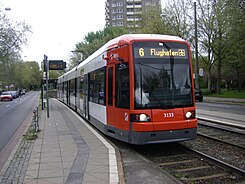H.-H.-Meier-Allee
| H.-H.-Meier-Allee | |
|---|---|
| Street in Bremen | |
| H.-H.-Meier-Allee with stop at Emmastraße | |
| Basic data | |
| city | Bremen |
| district | Schwachhausen |
| Created | 20th century |
| Cross streets | Schwachhauser Ring , Wyckstraße, Emmastraße, Gevekohtstraße, Baumschulenweg, Klattenweg, Kulenkampffallee , Wätjenstraße , Heinstraße |
| use | |
| User groups | Cars, trams, bicycles and pedestrians |
| Road design | two lane road |
| Technical specifications | |
| Street length | 1200 meters |
The H.-H.-Meier-Allee (on Google-maps Hermann-Henrich-Meier-Allee ) is a central access road in Bremen , district Schwachhausen on the border of the districts Neu-Schwachhausen and Riensberg . It leads from the Wachmannstrasse and the Schwachhauser Ring without a connecting road mainly in a south-north direction.
The cross streets and connecting streets were named u. a. as Wachmannstrasse after the Bremen council syndic and envoy Johann Wachmann the Elder (1592-1659), Schwachhauser Ring after the Ringstrasse around Bremen, Wyckstrasse 1939 after the Bremen council syndic Johann von der Wyck (? - 1534), who was burned as a heretic in Münster, Emmastraße 1890 after the benevolent landowner Countess Emma von Lesum (975 / 980-1038), Gevekohtstraße after the merchant and Bremen member Carl Theodor Gevekoht (1798-1850), Baumschulenweg 1925 after a former tree nursery , Klattenweg after an old Schwachhausen farming family, Kulenkampffallee 1957 after the Bremen merchant family, Wätjenstraße after the Bremen shipowners Diedrich Wätjen (1785–1858) and Heinrich Wätjen (1813–1887), Heinstraße 1955 after the owner of the area and four unnamed paths a. a. to the university and to Horn; otherwise see the link to the streets.
history
Surname
The H.-H.-Meier-Allee was named after the businessman, politician and co-founder of North German Lloyd (NDL) Hermann Henrich Meier (1809–1898).
The NDL was founded in 1857 by Meier (1809–1898) and Eduard Crüsemann (1826–1869) as the first director of the Bremen shipping company and by Gustav Kulenkampff (1811–1878). Meier was also a member of the Reichstag of the German Empire from 1881 to 1887 .
development
The district of Neu-Schwachhausen was not built on until after the Second World War in the 1960s. a. by the Bremer Beamtenbaugesellschaft (BBG) and the Bremer Schoss with multi-storey rental houses. The district had 5723 inhabitants (2009). The district of Riensberg, as the manor district of Riensberg, was a district between the villages of Schwachhausen and Horn. The district had 6203 inhabitants (2009).
traffic
In 1959, the route of line 16 from Wachmannstrasse to Riensberg was extended on H.-H.-Meier-Allee. In 1967 the previous line 16 was given line number 6 (Grolland from 1976 Huchting - Wachmannstraße - Riensberg). After a reorganization of the network, line 6 now ran from the airport to Riensberg and, after an extension in 1998, to the university.
The Bremen tram runs through the street today with line 6 (university - airport).
In local transport in Bremen, bus line 22 (Kattenturm-Mitte ↔ University) touches the street on Schwachhauser Ring.
Buildings and facilities
The street is predominantly built up with two to five-story residential buildings from the period after the Second World War in the 1960s to 1980s.
Notable buildings and facilities
- No. 1 to 21: 3-sch. Residential houses with pitched roofs
- No. 6 to 44: 3-ply Residential houses and residential and commercial buildings with pitched roofs
- No. 6 and 10: Restaurants
- No. 34: Lloyd Pharmacy and Sparkasse Bremen branch
- No. 40: Post Office
- No. 40a: Community center of the Church of Our Dear Women
- No. 42: Restaurant
- No. 50 to 60/70: 3-ply Residential complexes
- No. 51:15 High-rise residential building from 1964 based on plans by the architects Morschel , Henke and Hodde; only skyscraper in the district
- No. 53 to 85: 3-ply Residential houses with pitched roofs mostly in row construction
- Wätjenstrasse No. 113 to Heinstrasse: 5-storied. Residential houses with flat roofs
- Corner of Baumschulenweg: Schwachhausen weekly market - H.-H.-Meier-Allee
- No. 72/76 and Kulenkampffallee No. 184: newer 4-storey. Residential and commercial building
- No. 78 to 84c: Eight 1-sided Single family homes
- Behind allotment gardens in the allotment gardeners association Kornblume
- Required reversing loop of the tram
- Green zone: 28.1 hectare park cemetery Riensberg from 1875 (garden architect Wilhelm Benque ) with Riensberger lake, chapel, columbarium and former crematorium from 1907
- No. 80: Riensberg Jewish cemetery from 2008 with access from Beckfeldstrasse
- Paths towards the university or Riensberger Straße in Horn-Lehe , Horn district.

Monuments
- Countess Emma and Duke Benno from 1988 made of bronze by the sculptor Thomas Recker on the corner of Emmastraße. Memory of a legend from 1032. Countess Emma von Lesum (975 / 980-1038) bequeathed the citizens of Bremen to the citizens of Bremen, at that time between Utbremen and Schwachhausen. Her brother-in-law Benno, Duke Bernhard I of Saxony (around 950 / 973-1011), however, decreed that the donation should only include that part of the site that a cripple could crawl around from sunrise to sunset.
See also
literature
- Herbert Black Forest : The Great Bremen Lexicon. 2nd, expanded and updated edition. In two volumes. Edition Temmen , Bremen 2003, ISBN 3-86108-693-X (first edition: 2002, supplementary volume A – Z). 2008, ISBN 978-3-86108-986-5 .
- Monika Porsch: Bremer Straßenlexikon , complete edition. Schünemann, Bremen 2003, ISBN 3-7961-1850-X .
Individual evidence
- ^ Fritz Specht, Paul Schwabe: The Reichstag elections from 1867 to 1903. Statistics of the Reichstag elections together with the programs of the parties and a list of the elected representatives. 2nd Edition. Carl Heymann Verlag, Berlin 1904, pp. 293-294.
Coordinates: 53 ° 5 ′ 32.3 " N , 8 ° 50 ′ 47.7" E




